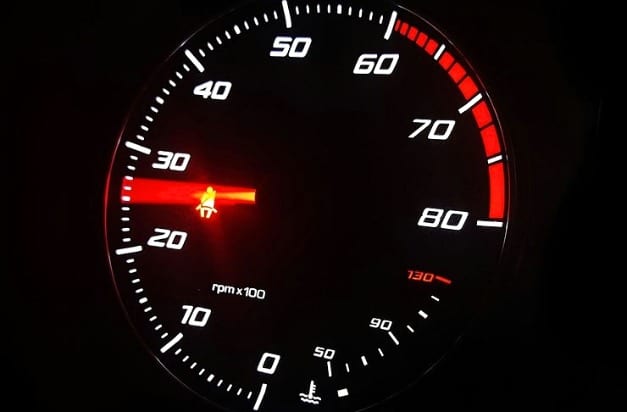
Car tachometer - what is it and what is it for
Content
- Car tachometer
- What is a tachometer for cars
- Why do you need a tachometer
- Principle of operation of the device
- Tachometer design
- Types and types of tachometers
- How to use the tachometer information?
- How is the tachometer connected to auto sensors
- Major faults
- The main malfunctions of tachometers
- How to choose a tachometer
- Tachometer Installation Methods
- Related videos
- Questions and answers:
Car tachometer
Next to the speedometer on the dashboard of all modern cars is a tachometer. Some mistakenly believe that this device is useless for the average driver. In fact, the tachometer plays an important role for the proper operation of the engine.
How does the device work, what are they, how is the tachometer related to the efficient operation of the motor, and how to install it correctly? All this later in our review.
What is a tachometer for cars
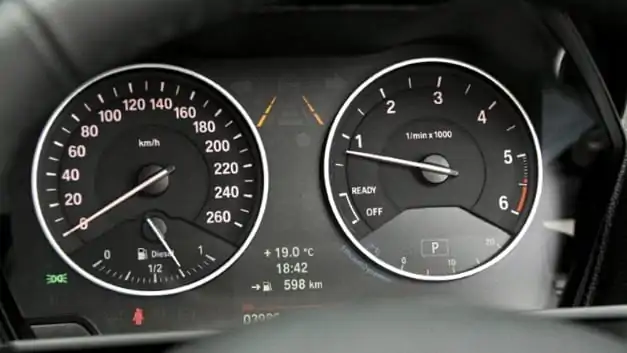
A tachometer is a device connected to engine crankshaft, to measure the frequency of its rotation. It looks like a sensor with an arrow and a scale. Most often, the functions of this device are used by motorists who love fast driving. On a manual gearbox or automatic transmission in manual mode, it is possible to “untwist” the engine to maximum speed in order to get the best dynamics when switching speeds.
Here are a few reasons why a tachometer is needed in every car.
- The operation of the internal combustion engine at reduced speeds (up to 2000 rpm) significantly reduces fuel consumption, however, there will be associated problems. For example, when shifting to high gear, the motor experiences a heavy load. The fuel mixture in the combustion chamber is distributed unevenly, from which it burns poorly. As a result, soot formation on the cylinders, spark plugs and pistons. At reduced speeds, the oil pump creates insufficient pressure to lubricate the engine, which causes oil starvation, and the crankshaft components wear out quickly.
- Constant operation of the engine at high speeds (more than 4000) not only leads to an excessive consumption of fuel, but also significantly reduces its resource. In this mode, the internal combustion engine overheats, the oil loses its properties, and the parts quickly fail. How to determine the optimal indicator, within which you can "twist" the motor?
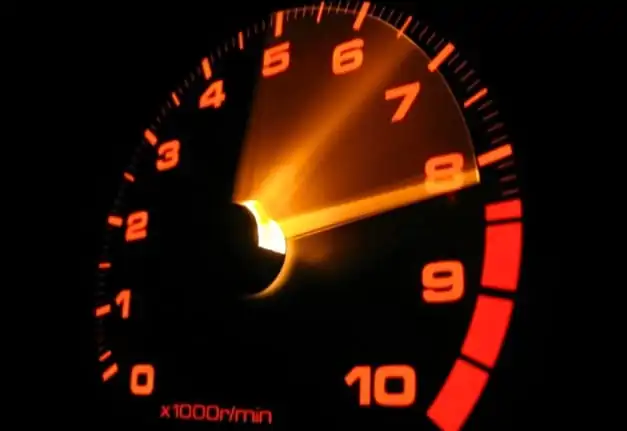
To this end, manufacturers install a tachometer in cars. The optimal indicator for the motor is considered to be in the range from 1/3 to 3/4 revolutions, at which the motor gives maximum power (this indicator is indicated in the technical documentation of the machine).
Each car has its own interval, so the driver should focus not only on the experience of the owners of the "combat classic", but on the manufacturer's recommendations. To determine this value, the tachometer scale is divided into several zones - green, yellow (sometimes it is a colorless gap between green and red) and red.

The green zone of the tachometer scale indicates the economical operation of the motor. In this case, the car will have poor dynamics. When the arrow moves to the next zone (usually an indicator above 3500 rpm.), The engine consumes more fuel, but at the same time develops maximum power. At these speeds it is necessary to accelerate, for example, during overtaking.
In winter, you can’t do without a tachometer either, especially during the warming up of an engine equipped with a carburetor. In this case, the driver adjusts the number of revolutions with the “suction” lever. Warming up the engine at high speeds is harmful, since the output at the operating temperature should be smooth (see the operating temperature of the motor in a separate article) The sound of the motor is extremely difficult to determine this indicator. To do this, you need a tachometer.
Modern cars themselves regulate the increase / decrease in speed in the process of preparing the engine for the trip. In such cars, this device will help the driver determine the moment of switching speeds.
About how to focus on tachometer performance while riding, see the video:
Why do you need a tachometer
The presence of this device does not in any way affect the operation of the vehicle and its individual systems. Rather, it is a device that allows the driver to control the operation of the motor. In older cars, engine speed could be detected by sound.
The vast majority of modern cars have excellent noise isolation, due to which even the sound of the engine is poorly audible. Since the constant operation of the engine at high speeds is fraught with failure of the unit, this parameter must be monitored. One of the situations in which the device will be useful is determining the time of switching on an up or down gear when accelerating a car.
For this purpose, a tachometer is installed in the dashboard, designed for a specific motor. This device can indicate the optimal number of revolutions for a given unit, as well as the so-called red border. Long-term operation of the internal combustion engine is undesirable in this sector. Since each engine has its own maximum speed limits, the tachometer must also be matched to the parameters of the power unit.
Principle of operation of the device
Tachometers operate as follows.
- Activated ignition system starts engine. The air-fuel mixture in the combustion chamber ignites, which drives the connecting rods of the piston group. They rotate the crankshaft of the motor. Depending on the model of the device, its sensor is installed on the desired motor unit.
- The sensor reads the engine speed indicator. Then it generates pulses and transmits them to the device control unit. There, this signal either activates the arrow drive (moves it on the scale) or gives a digital value, which is displayed on the corresponding dashboard screen.
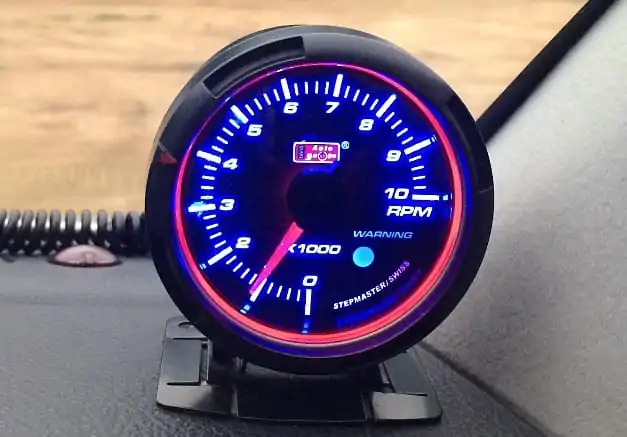

A more accurate principle of operation of the device depends on its modification. There is a wide variety of such devices. They differ from each other not only externally, but also in the connection method, as well as in the data processing method.
Tachometer design
All tachometers are conditionally divided into three categories.
1. Mechanical. This modification is used in old cars and motorcycles. The main part in this case is the cable. On the one hand, it is connected to the camshaft (or crankshaft). The other end is fixed in the receiving mechanism, located behind the scale of the device.
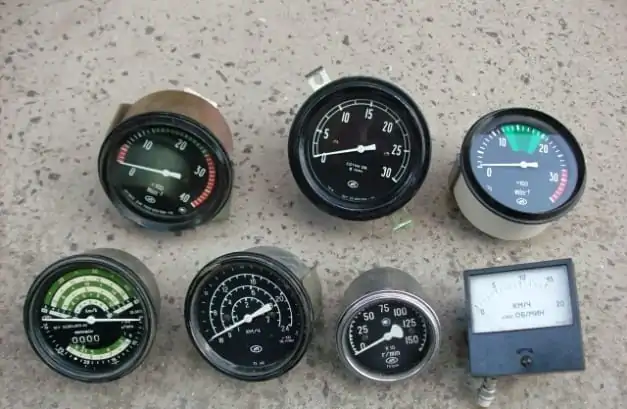

During the rotation of the shaft, the central core rotates inside the casing. Torque is transmitted to the gears to which the arrow is connected, which sets it in motion. Most often, such devices were installed on low-speed motors, so the scale in them is divided into segments with a value of 250 rpm. each.
2. Analogue. They are equipped with cars whose age exceeds 20 years. Advanced options are installed on modern budget cars. Visually, such a modification is very similar to the previous one. It also has a round dial with an arrow moving along it.
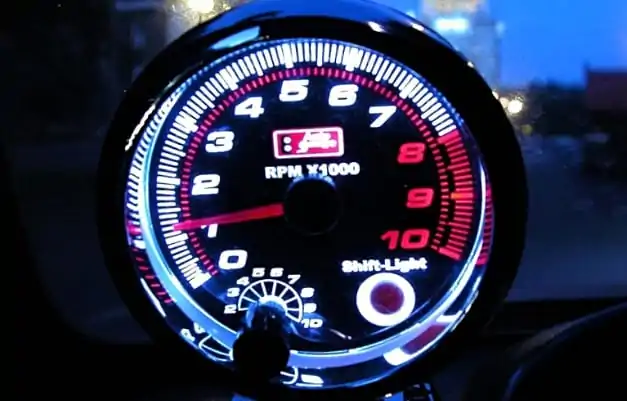

The main difference between an analog and a mechanical tachometer is in the transmission mechanism of the rpm indicator. Such devices consist of four nodes.
- Sensor. It connects to the crankshaft or camshaft to read revs.
- Magnetic coil. It is installed in the tachometer housing. A signal is received from the sensor, which is converted into a magnetic field. Almost all analog sensors work on this principle.
- Arrows It is equipped with a small magnet that responds to the strength of the field arising in the coil. As a result, the arrow deviates to the appropriate level.
- Scales. The divisions on it are the same as in the case of a mechanical analogue (in some cases it is 200 or 100 rpm.).
Such models of devices can be standard and remote. In the first case, they are mounted in the dashboard next to the speedometer. The second modification can be installed in any suitable place on the dashboard. Basically, this category of devices is used if the machine is not equipped with such a device from the factory.
3. Electronic. This type of device is considered the most accurate. They consist of a larger, compared with previous options, the number of elements.
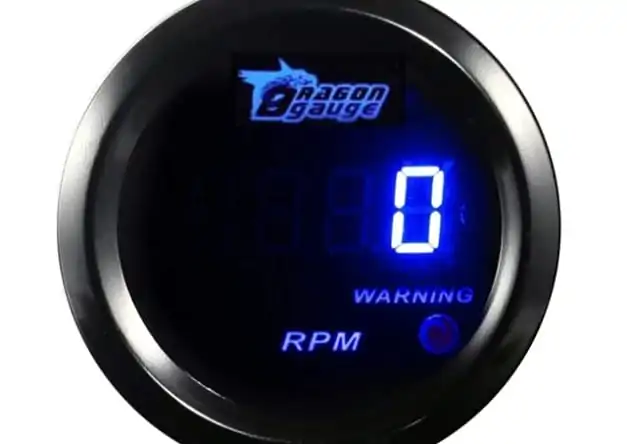

- A sensor that reads the rotation indicators of the shaft on which it is mounted. Pulses are formed in it, transmitted to the next node.
- The processor processes the data and transmits a signal to the optocoupler.
- Optron converts electrical pulses into light signals.
- Display. It displays an indicator that the driver understands. Data can be displayed either in the form of numbers, or in the form of a virtual graded scale with an arrow.
Often in modern cars, the digital tachometer is connected to the electronic control unit of the car. So that when the ignition is off, the device does not consume battery power, it automatically turns off.
Types and types of tachometers
There are three types of tachometers in total:
- Mechanical type;
- Analog type;
- Digital type.
However, regardless of the type, tachometers can be standard and remote according to the installation method. The element that fixes the crankshaft speed is mainly installed in its immediate vicinity, namely, near the flywheel. Often the contact is connected to the ignition coil or to the crankshaft sensor contact.
Mechanical
The very first modification of tachometers was just mechanical. Its device includes a drive cable. One end with a slider connects to the camshaft or crankshaft and the other to the tachometer gearbox.
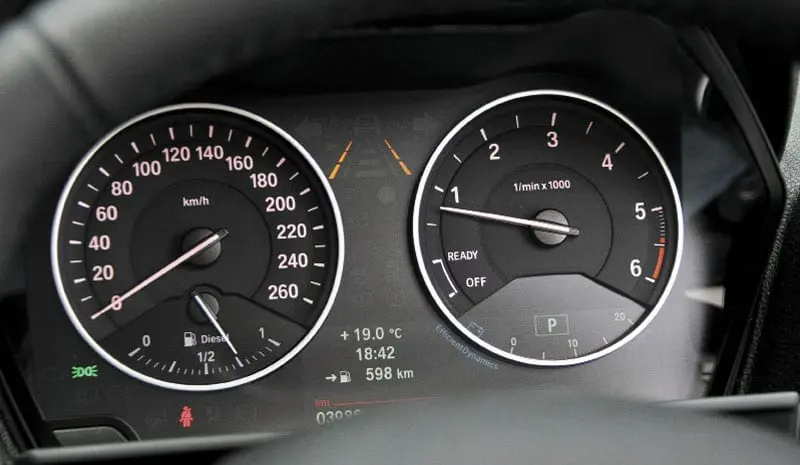

The torque is transmitted to the gearbox, which drives the magnetic mechanism. That, in turn, deflects the tachometer needle by the required amount. This type of device has a large error (up to 500 rpm). This is due to the fact that the cable twists during the transfer of force, which distorts the real values.
Analog
A more advanced model is an analog tachometer. Outwardly, it is very similar to the previous modification, but it differs in the principle of transmitting the torque value to the arrow drive.
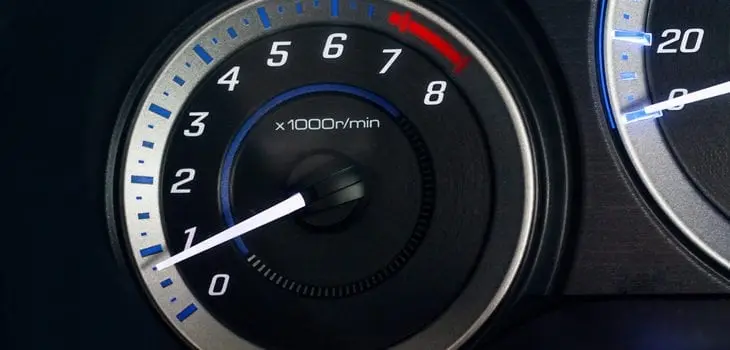

The electronic part of the device is connected to the crankshaft position sensor. There is a magnetic coil inside the tachometer that deflects the needle by the required amount. Such tachometers also have a large error (up to 500 rpm).
digital
The most recent modification of tachometers is digital. Turnovers can be displayed as glowing numbers. In more advanced models, a virtual dial with an arrow is displayed on the screen.
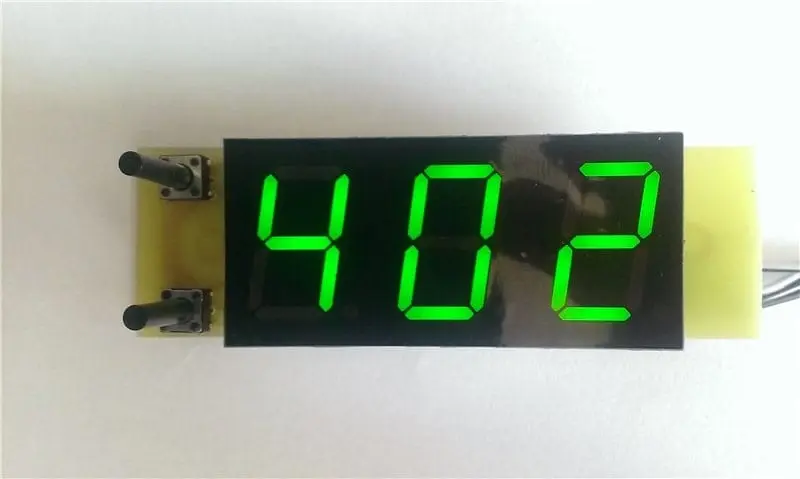

Such a device is also connected to the crankshaft sensor. Only instead of a magnetic coil, a microprocessor is installed in the tachometer unit, which recognizes the signals coming from the sensor and outputs the corresponding value. The error of such devices is the smallest - about 100 revolutions per minute.
Established
These are tachometers that are installed in the car from the factory. The manufacturer selects a modification that will show the rpm values as accurately as possible and indicate the maximum parameters allowed for a given motor.
These tachometers are the most difficult to repair and replace because they are installed in the dashboard. To turn off and install a new device, it is necessary to dismantle the entire dashboard, and sometimes even a dashboard (depending on the car model).
Remote
It is much easier with remote tachometers. They are installed anywhere on the vehicle console wherever the driver wants. Such devices are used in machines in which a tachometer is not provided from the factory.
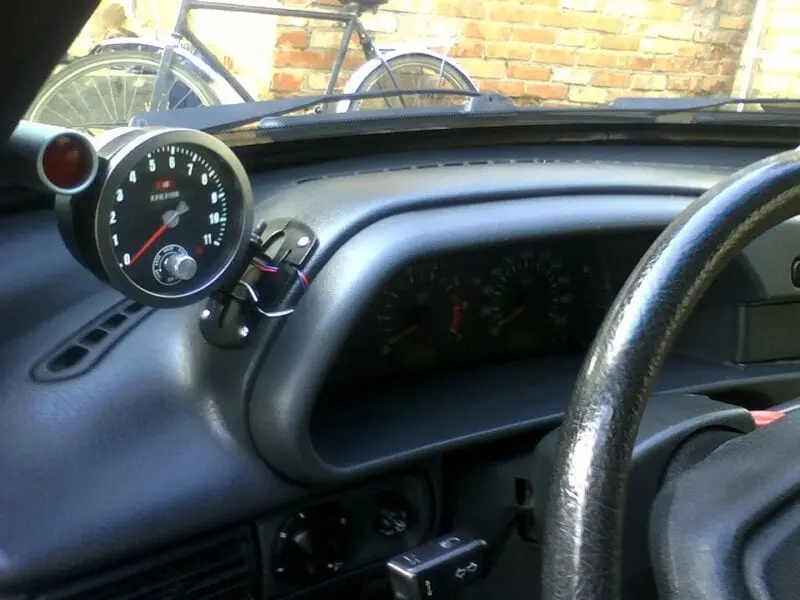

Most often, such devices are digital or at least analog, since their location does not depend on the length of the cable. Basically, such tachometers are installed in close proximity to the dashboard. This allows the driver to control the engine speed without being distracted from the road.
How to use the tachometer information?
The tachometer readings help the driver navigate different situations. First of all, this device helps not to bring the power unit to critical speed. The maximum speed is only allowed in case of emergency operation. If you constantly operate the motor in this mode, it will fail due to overheating.
The tachometer determines at what moment you can switch to higher speed. Experienced motorists also use a tachometer to correctly shift to a lower gear (if you turn on neutral and turn the gear lower at idle, the car will bite due to the speed of rotation of the driving wheels less than they rotated before).
If you focus correctly on the tachometer readings, you can reduce fuel consumption (the sport mode with frequent high rpm necessarily consumes more fuel). Timely gear shifting also allows you to increase the working life of the parts of the cylinder-piston group or to choose a suitable driving mode.
Tachometers from different car models are not interchangeable, because these elements are created for specific types of engines and cars.
How is the tachometer connected to auto sensors
When buying a new tachometer, a motorist may notice that there is no separate sensor in the kit. In fact, the device is not equipped with an individual sensor, which is mounted on the motor shaft. It is simply not necessary. It is enough to connect the wires to one of the following sensors.
- Crankshaft sensor It fixes the position of the cranks in the 1st cylinder of the engine and delivers an electrical impulse. This signal goes to the magnetic coil or to the processor (depending on the type of device). There, the impulse is converted to the appropriate value and then displayed on a scale or dial.
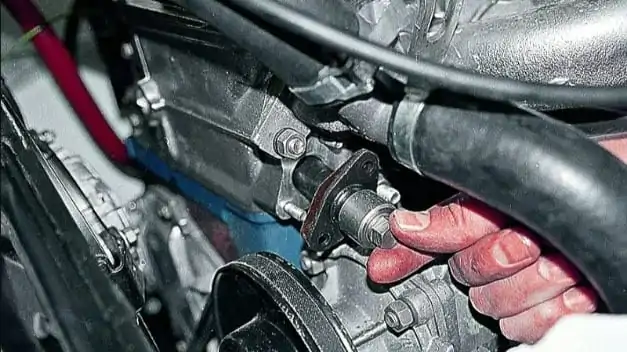

- Idling sensor (correct valve XX). In injection engines, he is responsible for supplying air to the intake manifold, bypassing the throttle valve. In carburetor engines, this regulator controls the supply of fuel to the idle channel (when braking the engine, it blocks the flow of gasoline, which leads to fuel economy). By the amount of fuel that regulates the valve, the engine speed is also determined.
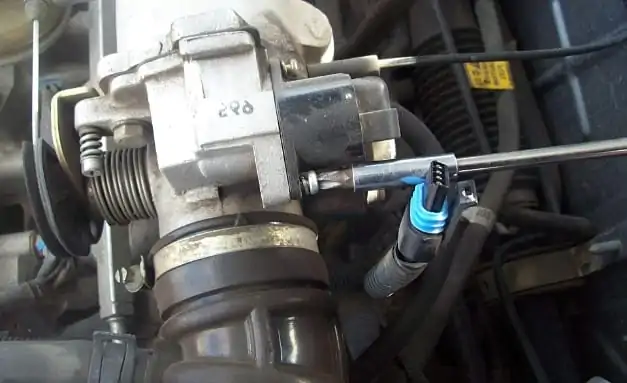

- ECU Modern tachometers are connected to the electronic control unit, which receives signals from all sensors connected to the engine. The more data comes in, the more accurate the measurements will be. In this case, the indicator will be transmitted with a minimum error.
Major faults
When the tachometer needle does not deviate during engine operation (and in many old car models this device is not provided at all), the driver will have to determine the speed by the sound of the internal combustion engine.
The first sign of a malfunction in the operation of a mechanical (analog) tachometer is a violation of the smooth movement of the arrow. If it jams, twitches, or jumps / falls sharply, then you need to diagnose why the tachometer behaves this way.
Here's what to do if the tachometer does not work properly:
- Check the power wire (for a digital or analog model) - the contact may disappear or it is bad;
- Measure the voltage in the on-board network: it must be within 12V;
- Check the contact of the negative wire;
- Check for blown fuse.
If no malfunctions have been identified in the on-board network, then the problem is in the tachometer itself (in its mechanical part).
Causes and solutions
Here's how to fix some tachometer malfunctions:
- There is no voltage in the tachometer circuit - check the integrity of the wires and the quality of the contact at the terminals. If a wire break is detected, then it must be replaced;
- The sensor drive is interrupted - the sensor must be replaced;
- If, when starting the motor, the arrow does not just not spin, but noticeably deviates in the opposite direction, this is a sign of a polarity reversal of the device. To eliminate this effect, it is enough to swap the wires.
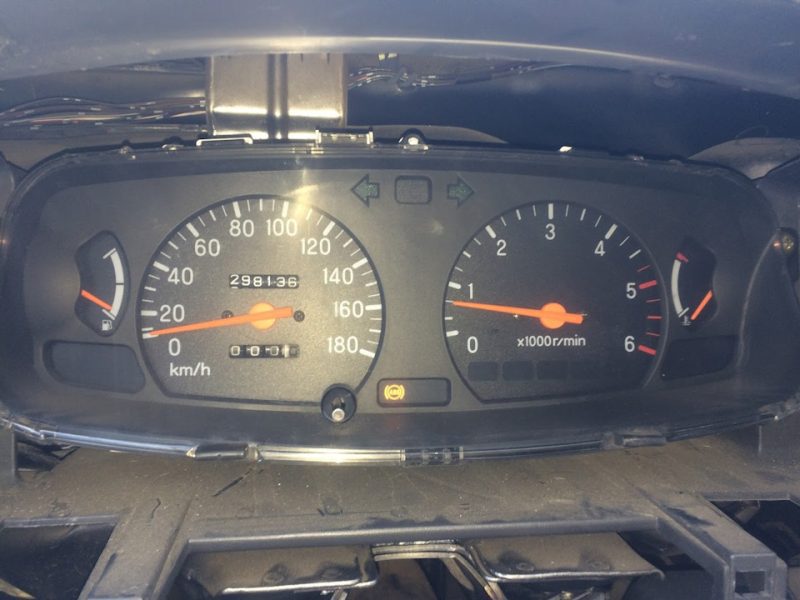

The arrow may run unevenly in the following cases:
- Low output voltage at the sensor. If the voltage in the circuit is correct, then the sensor must be replaced.
- Debris has fallen into the magnetic clutch (applies to analogue tachometers) or is demagnetized.
- A defect has formed in the mechanism drive. If, with the engine off, the arrow deviates beyond the 0 mark, then the spring must be replaced or bent.
In most cases, malfunctions in the tachometer itself are not eliminated in any way, so the part is replaced with a new one. To make sure that the fault is in the tachometer, a known working tachometer is installed instead of it and its performance is checked.
If the values are also incorrect or the arrow works identically, then the problem is not in the tachometer, but in the on-board network. Deviations in the tachometer readings from the norm are permissible in the range from 100 to 150 rpm.
If the car is equipped with an on-board computer, then if the tachometer malfunctions, the corresponding error code will appear on the BC screen. When the arrow moves chaotically, twitches, pulsates, this is a sign of failure of the tachometer sensor - it must be replaced.
The main malfunctions of tachometers
The malfunction of the tachometer can be judged by the following symptoms:
- At idle of the internal combustion engine, the arrow constantly changes its position, but according to the sensations, the engine runs smoothly.
- The indicator does not change, even with a sharp pressure on the accelerator pedal.
In the first case, you need to make sure that the malfunction is indeed in the tachometer, and not in the ignition or fuel supply system to the engine. To do this, raise the hood and listen to the engine. If it functions smoothly, and the arrow changes its position, then you need to pay attention to the device itself.
The main cause of the failure of analog and digital models is a broken contact in the electrical circuit. First of all, you need to check the quality of the wire connections. If they are made using "twisting", then it is better to fix the nodes using special terminal clamps with bolts and nuts. All contacts must be stripped.
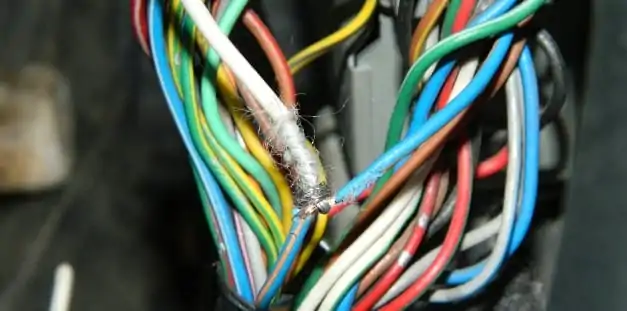

The second thing to check is the integrity of the wires (especially if they are not fixed and are next to the moving elements). The procedure is performed using a tester.
If the standard diagnostics did not reveal a malfunction, then it is necessary to contact auto electricians. They will check the operability of other nodes involved in measuring the engine speed.
If the car is equipped with a mechanical tachometer, then there can be only one breakdown in it - failure of the drive or the cable itself. The problem is solved by replacing the part.
How to choose a tachometer
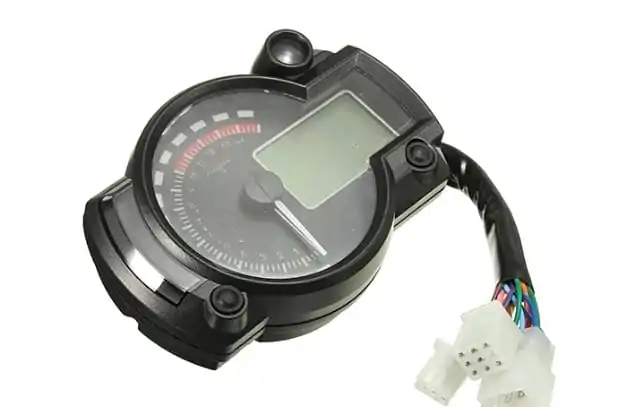

Each tachometer modification has its own advantages and disadvantages.
- Mechanical models have a large error in the calculations (it is up to 500 rpm), so they are practically not used. Another drawback is the natural wear of gears and the cable. Replacing such elements is always a laborious process. Since the cable is made of twisted wire, due to the difference in twisting, the speed indicator will always be different from the real one.
- The accuracy of analog models is also within 500 rpm. Only in comparison with the previous version, this device works more stably, and the data will be much closer to the real indicator. For the device to work, it is enough to correctly connect the wires to the electrical circuit. Such a device is installed on the intended place in the dashboard or as a separate sensor (for example, on a windshield pillar so as to notice a change in parameters with lateral vision).
- The most accurate devices are electronic modifications, since they work exclusively on electrical signals. The only drawback of such a modification is the displayed information on the display. The human brain always works with images. When the driver sees the number, the brain must process this information and determine whether it matches the necessary parameter, if not, then how much. The position of the arrow on the graduated scale facilitates the process, so it is easier for the driver to perceive the arrow sensor and quickly respond to its change. For this, most modern cars are equipped not with digital tachometers, but with modifications with a virtual scale with an arrow.
If a standard tachometer is used in the car, then in the event of a breakdown, you must buy the same. Very rarely, a device from one car approaches another. Even if the device is placed in the corresponding landing connector, it will be configured to read the indicator of another motor, and in the factory configuration these options may differ. In the case of installing the device from another car, it will need to be adjusted to the performance of this engine.


Much easier with remote models. Most often they are used in those cars that are not equipped with similar devices. For example, these are old cars, some modern budget or compact models. Included with such devices will be a mount for installation on a dashboard.
Tachometer Installation Methods
Before you understand the wiring diagram of the meter, you must remember: installation on a gasoline engine is different from mounting on a diesel power unit. In addition, the tachometer for the generator and for the ignition coil count pulses in different ways, so when buying it is important to determine whether the model is suitable for this type of engine.
- Petrol. In some cases, a tachometer is connected to the electrical system. If the manual is missing, then you can use the scheme shown in the photo.


This is not the only way to connect. In the case of contact and non-contact ignition, the circuits will be different. The following video, using the UAZ 469 as an example, shows how to connect the device to a gasoline engine.


Watch this video on YouTube
- Diesel. In this case, the connection can be made through the generator. The video shows one of the installation options:


Watch this video on YouTube
After this connection method, the tachometer will need to be calibrated. Here's how to do it:


Watch this video on YouTube
So, the tachometer will help the driver competently operate the engine of his car. Speed indicators make it possible to determine the moment of gear shifting and control fuel consumption in the usual driving style.
Related videos
Here is a short video on how you can connect a remote tachometer:


Watch this video on YouTube
Questions and answers:
What is the difference between a tachometer and a speedometer? The devices work on the same principle. Only the tachometer shows the speed of rotation of the crankshaft, and the speedometer shows the front wheels in the car.
What does a tachometer measure in a car? The tachometer scale is divided into sectors indicating the engine speed. For ease of measurement, the division corresponds to one thousand revolutions per minute.
How many revolutions should there be on the tachometer? At idle, this parameter should be in the region of 800-900 rpm. With a cold start, the rpm will be at 1500 rpm. As the internal combustion engine warms up, they will decrease.
